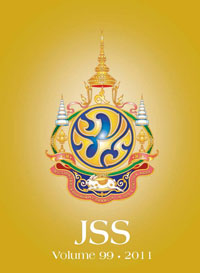Geomagnetism and the orientation of temples in Thailand
Main Article Content
Abstract
Traditionally a Buddha image should face eastward. Consequently, temples should be oriented in that same direction. Yet in China and elsewhere, the actual orientation has been shown to vary according to the time of construction. Orientations of ancient large temples and their associated structures in Thailand were measured and found to have similar variations. If the orientation of those temples was determined using a magnetic compass, the variation should reflect the Earth’s magnetic field drifting over time. The resulting estimates of the geomagnetic field show a westward drift at about 0.2° per year.
Article Details
How to Cite
Iyemori, T., Hashizume, M., Saito, A., Nose, M., Choosakul, N., Tsuda, T., & Odagi, Y. (2011). Geomagnetism and the orientation of temples in Thailand. The Journal of the Siam Society, 99, 139–149. retrieved from https://so06.tci-thaijo.org/index.php/pub_jss/article/view/158382
Issue
Section
Research Highlights


